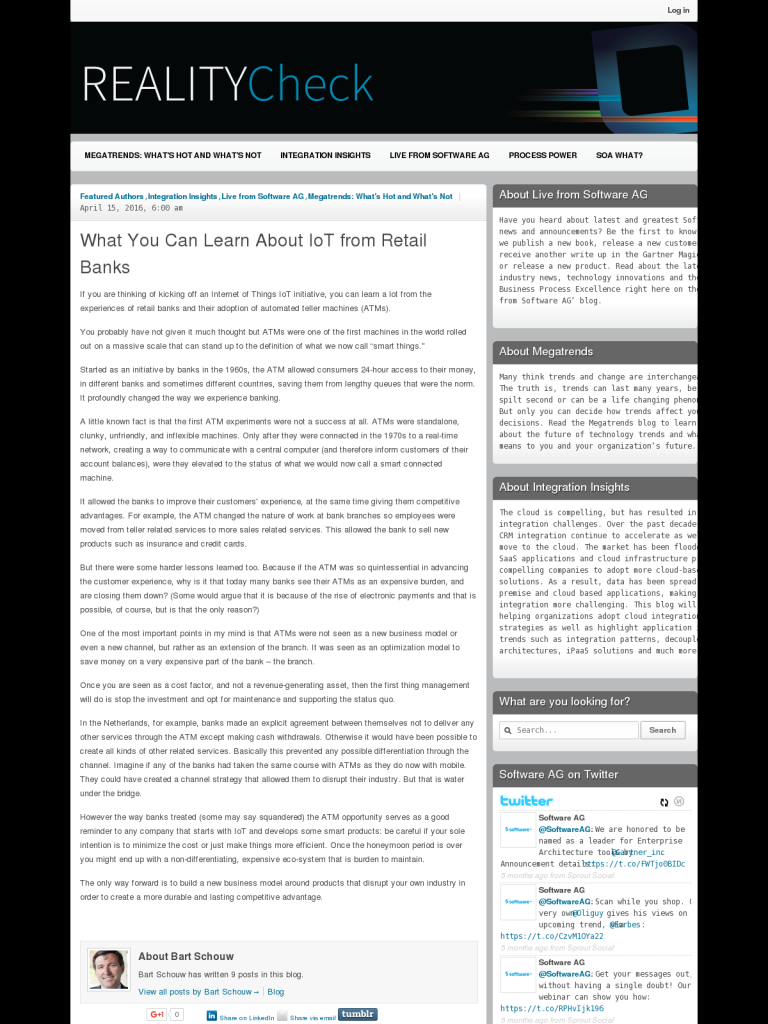What You Can Learn About IoT from Retail Banks
Blog: Software AG Blog - Reality Check
If you are thinking of kicking off an Internet of Things IoT initiative, you can learn a lot from the experiences of retail banks and their adoption of automated teller machines (ATMs).
You probably have not given it much thought but ATMs were one of the first machines in the world rolled out on a massive scale that can stand up to the definition of what we now call “smart things.”
Started as an initiative by banks in the 1960s, the ATM allowed consumers 24-hour access to their money, in different banks and sometimes different countries, saving them from lengthy queues that were the norm. It profoundly changed the way we experience banking.
A little known fact is that the first ATM experiments were not a success at all. ATMs were standalone, clunky, unfriendly, and inflexible machines. Only after they were connected in the 1970s to a real-time network, creating a way to communicate with a central computer (and therefore inform customers of their account balances), were they elevated to the status of what we would now call a smart connected machine.
It allowed the banks to improve their customers’ experience, at the same time giving them competitive advantages. For example, the ATM changed the nature of work at bank branches so employees were moved from teller related services to more sales related services. This allowed the bank to sell new products such as insurance and credit cards.
But there were some harder lessons learned too. Because if the ATM was so quintessential in advancing the customer experience, why is it that today many banks see their ATMs as an expensive burden, and are closing them down? (Some would argue that it is because of the rise of electronic payments and that is possible, of course, but is that the only reason?)
One of the most important points in my mind is that ATMs were not seen as a new business model or even a new channel, but rather as an extension of the branch. It was seen as an optimization model to save money on a very expensive part of the bank – the branch.
Once you are seen as a cost factor, and not a revenue-generating asset, then the first thing management will do is stop the investment and opt for maintenance and supporting the status quo.
In the Netherlands, for example, banks made an explicit agreement between themselves not to deliver any other services through the ATM except making cash withdrawals. Otherwise it would have been possible to create all kinds of other related services. Basically this prevented any possible differentiation through the channel. Imagine if any of the banks had taken the same course with ATMs as they do now with mobile. They could have created a channel strategy that allowed them to disrupt their industry. But that is water under the bridge.
However the way banks treated (some may say squandered) the ATM opportunity serves as a good reminder to any company that starts with IoT and develops some smart products: be careful if your sole intention is to minimize the cost or just make things more efficient. Once the honeymoon period is over you might end up with a non-differentiating, expensive eco-system that is burden to maintain.
The only way forward is to build a new business model around products that disrupt your own industry in order to create a more durable and lasting competitive advantage.
The post What You Can Learn About IoT from Retail Banks appeared first on Reality Check.
Leave a Comment
You must be logged in to post a comment.








